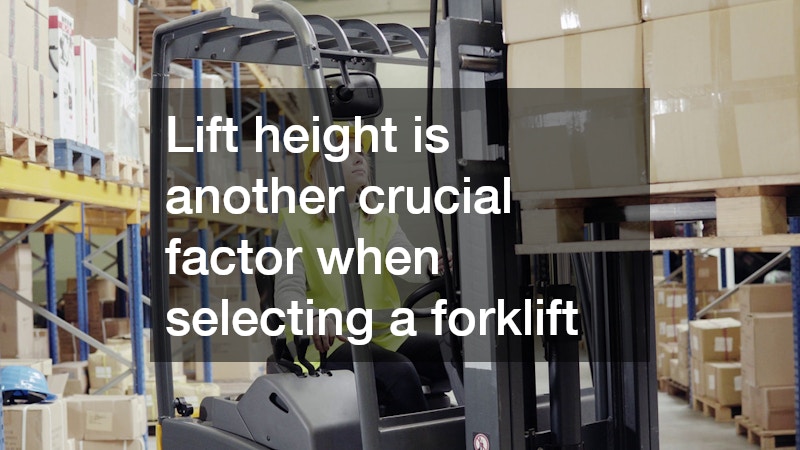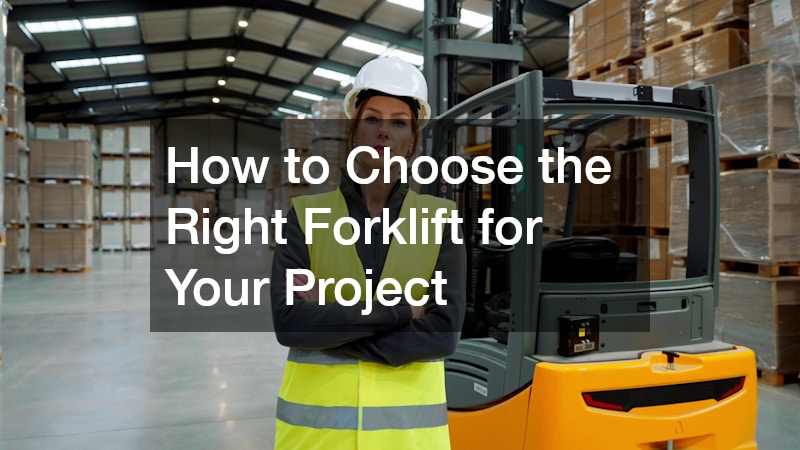
This article will guide you through the essential considerations and steps involved in selecting the most suitable forklift for your specific project needs. Whether you’re managing a large-scale construction project or operating a small warehouse, the right forklift can enhance productivity and safety. Understanding the different types of forklifts and their specific features will help you make an informed decision when working with a forklift company.
What Types of Forklifts Are Available?
Electric forklifts are popular for their eco-friendly operations and efficiency in indoor environments. They are powered by batteries, emit zero emissions, and generally have lower operating costs compared to fuel-powered models.
However, they require significant charging time and may not perform as effectively in outdoor or all-weather conditions.
Many businesses prefer electric forklifts for their quiet operation, which is ideal for indoor activities where noise could be a concern. The typical lifespan of an electric forklift battery can affect scheduling, as frequent recharging is necessary to maintain productivity. Warehouse operations often choose electric forklifts when environmental sustainability is a priority.
An important consideration is the maintenance of electric forklifts, which is usually less intensive than that of internal combustion models. The fewer parts and simpler mechanics can result in reduced long-term service costs. Nevertheless, the initial investment for electric forklifts is often higher due to the cost of the battery.
Internal combustion forklifts, powered by diesel, gasoline, or LPG, are known for their high power and flexibility in varied environments. These forklifts are suitable for both indoor and outdoor applications, especially where substantial lifting power is required. Despite being quite powerful, they emit fumes, making indoor use a concern without proper ventilation.
The robustness of internal combustion forklifts makes them ideal for heavy-duty operations and challenging terrains. However, their higher noise levels compared to electric models can be disruptive in enclosed spaces. The cost of fuel and more frequent servicing also implies a higher total cost of ownership over time.
How to Determine the Right Capacity and Size?
Assessing load capacity is critical in selecting the appropriate forklift for your project. The load capacity of a forklift must match or exceed the heaviest load needed for your operations to prevent safety risks. Businesses must consider not only the weight of the loads but also their distribution, as uneven weight can compromise stability.
Operators should verify the forklift’s data plate, which indicates the safe lifting capacity under different conditions. It is also important to account for any additional attachments, as they may alter the forklift’s effective capacity. Regular training and assessments are recommended to ensure operators understand and respect these limits for safe operations.
Choosing a forklift with adequate capacity prevents equipment strain and potential mechanical failures. Overloading can lead to equipment damage, costly repairs, and disruptions in workflow. Investing in a correctly rated forklift ultimately saves on maintenance costs and enhances operational efficiency.
Lift height is another crucial factor when selecting a forklift, particularly in warehousing and storage applications. Different warehouses require forklifts to reach varying heights to maximize vertical space usage. The lift height must match the peak storage locations to maintain accessibility and efficiency in inventory management.
Forklifts with adjustable lift heights offer flexibility across different project requirements. Understanding the maximum and minimum lift heights needed can guide your selection, ensuring that goods are both safely stored and accessible. Additional factors such as overhead obstructions and shelving sizes should also be considered during evaluation.
Safety is a prime concern when working with varying lift heights, as the stability of the forklift diminishes at greater elevations. Operators must be trained to handle loads carefully, avoiding abrupt movements that could cause tipping. A reliable forklift design will minimize risks and ensure smooth operation at all heights.
What Factors Influence Forklift Cost and Ownership?
Understanding the cost implications of purchasing a forklift involves considering both the initial expenditure and the long-term ownership costs. While the upfront cost may be more visible, ongoing expenses such as maintenance, repairs, and fuel can significantly impact the total cost of ownership. Businesses should perform a detailed cost-benefit analysis to balance initial and future financial responsibilities.
Long-term expenses are influenced by the type and frequency of forklift use, as higher-intensity operations typically require more maintenance. Choosing a model with efficient fuel consumption and durable components can reduce these recurring expenses. Additionally, investing in quality equipment minimizes downtime and prolongs the forklift’s operational life.
Budget considerations should also include potential resale or trade-in values, which can offset the total investment. Evaluating these financial aspects thoroughly ensures that the selected forklift aligns with the project’s economic capacity while fulfilling operational needs. Strategic planning leads to informed purchasing decisions that align with business goals.
When deciding between renting and purchasing a forklift, project duration and budget constraints are pivotal factors. Renting a forklift may offer greater flexibility and reduce upfront costs, making it an attractive choice for short-term projects. However, long-term use could render rentals more expensive over time compared to purchasing.
Ownership allows for consistent access, control over equipment, and better cost efficiency for ongoing operations. Companies with regular forklift needs may find more value in purchasing machinery, ensuring predictable expenses and equipment availability. It’s important for businesses to evaluate the frequency and scale of operations to make a suitable choice.
Rentals also provide the opportunity to test different forklift types and configurations before committing to a purchase. This can be advantageous in rapidly changing industries where needs might evolve over time. By assessing each option for financial viability and operational fit, businesses can optimize their logistic capabilities and achieve effective results.
Summarizing the factors involved in selecting the appropriate forklift for your project leads to more confident and effective decision-making. The right forklift enhances productivity while aligning with budgetary and operational considerations. By carefully evaluating types, capacities, and cost implications, you can ensure project success and sustained logistical performance.
Each project presents unique challenges that require tailored solutions, emphasizing the importance of a comprehensive assessment process. With the insights from this guide, you will be equipped to choose the forklift that best fits your specific needs. Investing time into detailed evaluation enables better resource utilization and long-term business efficiency.
Ultimately, the selection of a forklift is a balance between capabilities, cost, and operational suitability. Emphasizing safety, functionality, and economic impact ensures that the chosen equipment contributes positively to the project outcomes. The right forklift not only facilitates daily operations but also supports your overarching business goals in the long term.

